Samuel Summerfield was born in Osmaston in South Derbyshire in 1894. Records show by his sixth birthday his parents Samuel and Alice Summerfield had arrived and were living in the small community of Sysonby near Melton, they set up as graziers and produced meat for the local market.
Samuel junior was one of eight children and their second son. Ten years on the family were established in their own butchers shop and young Samuel seemed already obsessed with the idea of flight‘. When not working as a clerk at the Gas works in town, the majority of his spare time and money was directed towards his hobby.
As a young teenager Samuel is recorded as supplying aviation materials by mail order from an address in Sherrard Street. Surrounded by the materials he needed to construct a rudimentary flying machine, it was not long before he was able, at the age of 15 – from eyewitness accounts given by local inhabitants, to glide aboard home-made machines at around the time of Bleriot‘s great achievement.
The Flight magazine published 4th March 1911 published the following:
“Catalogue: Model and Full size aeroplanes, Engines and Accessories. S Summerfield, Sherrard Street, Melton Mowbray. Price 3d.”
In September 1912, Sams enthusiasm and focus shown as a youth, together with a series of flying lessons as a teenager had paid off. Samuel Summerfield was awarded a prestigious Aviators Certificate; No. 292 from the Royal Aero Club of the United Kingdom having passed the necessary test on a Bristol biplane.
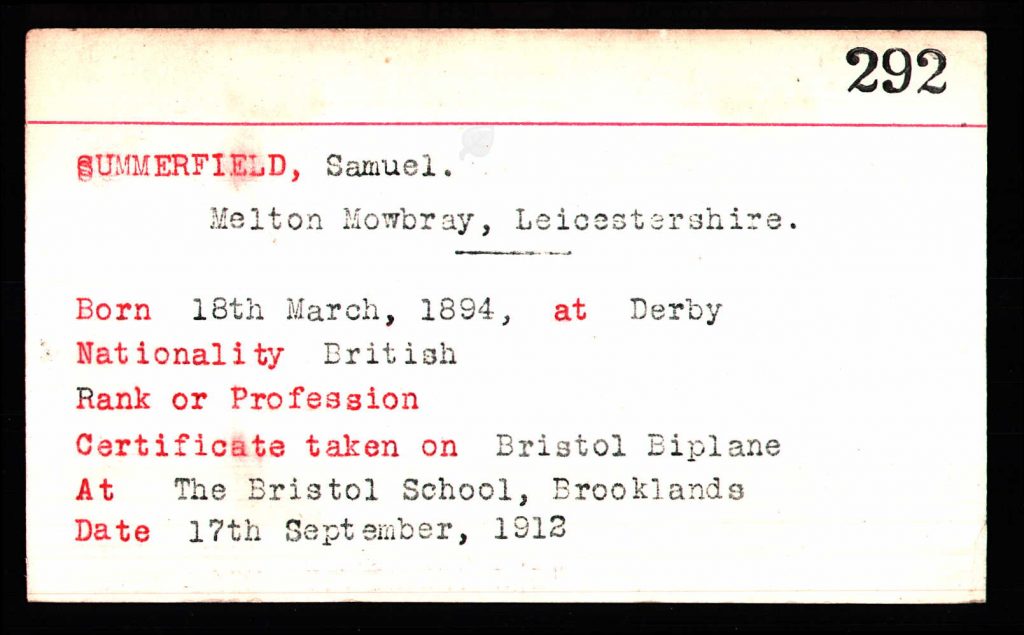
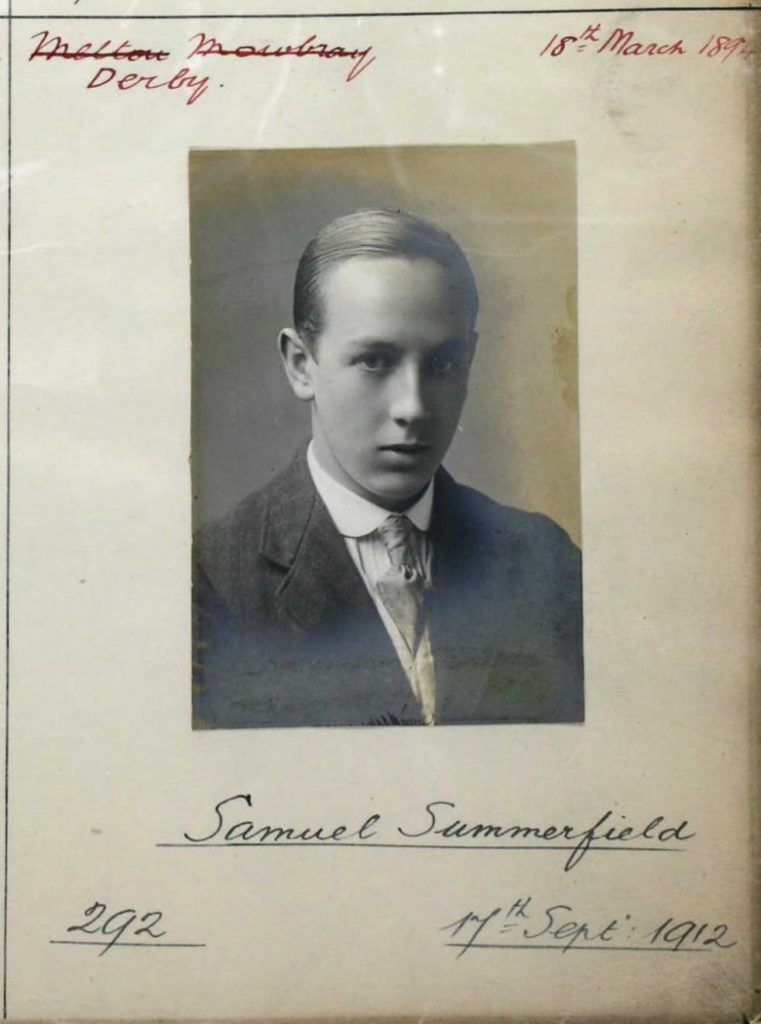
The Melton Mowbray Mercury and Oakham and Uppingham News reported on the 31 July 1913 “A large company assembled on the Nottingham Road ground on Saturday to witness an exhibition by Mr Sam Summerfield, of Melton Mowbray, on his Bleriot monoplane. Considerable delay was occasioned by a mishap to the machine, and when eventually the local airman attempted a flight, he was caught by a gust of wind directly after leaving the ground and ran with considerable force into a hedge. The machine was partially wrecked but Mr Summerfield escaped with slight injuries. In the evening, Mr F Manley made a very successful parachute descent.

Sam sorted out each problem as it arrived and he was known to use two or three different fields, all reasonably close the edge of the town, with possibly ‘his first choice being the Polo ground which lies just south of the railway line that passes the village of Brentingby. Long used as a sports venue, it was an unobstructed and level area of grassland that would have suited his needs adequately.
His second choice was likely to have been the large field that stretched between Nottingham Road, at the junction next to Sysonby Lodge Farm and the rear of the Wymondham Grammar School Farm on Scalford Road. This was a venue which was later to be used by the Government during the period of the Great War by the fledgling members of the new Royal Flying Corps.
Much later, during the 1920‘s, Sam would use the new landing field which was then situated at what is now Norfolk Drive, which runs between Sandy Lane and the Burton Road, but this was at a time when the phenomenon of flying an aeroplane had lost some of its pioneering zeal and a club had been started in Melton for the many new recruits and enthusiasts.
The Flight magazine of 20th December 1913 contained the following article: Mr. Summerfield at Melton Mowbray. In anything but ideal weather Mr. S. Summerfield made a fine flight on his Bleriot machine at Melton Mowbray last Saturday. For most of the time he kept about 1,000 feet up and came down by a splendid spiral vol plane’. There was one apprehensive moment when the machine side-slipped, but the pilot skilfully corrected that in good time.
Shortly afterwards, on the 26th June, the magazine reported ―Mr. Summerfield, of Melton Mowbray, who has recently been flying the Watson rocking wing machine at Buc, had a narrow escape whilst flying his Bleriot monoplane recently. He was coming down in a steep spiral, and, when trying to flatten out at a height of about 50 ft., found that one of his rudder control wires had come adrift, thus rendering the rudder useless. Taking his feet off the rudder bar and placing them on the tank he awaited the smash. The machine struck the ground with great force and was totally wrecked, but Mr. Summerfield escaped practically unhurt. He is of the opinion that had he kept his feet on the rudder bar he would have broken his legs.

In 1914 as the world was engaged in the Great War, the Summerfield family were affected, just like many others across the country. On the Melton Mowbray war memorial, there is a S Summerfield listed and it is often thought to be Sam.
Sam was the Chief Flying Instructor at the Bournemouth Flying School which had been established by the Bournemouth Aviation Company on farmland at Talbot Village. It was used to train prospective Royal Flying Corps (RFC) pilots and, although it was wartime, flights were also available to the public at a cost of £3.
The school was equipped initially with three Caudron type Biplanes of 35,45 & 60 Horsepower and , under the instruction of the chief instructor ,Mr S Summerfield,the pupils built another similar machine.By August 1916 there were 4 aircraft and an additional instructor – Mr E Brynildsen.
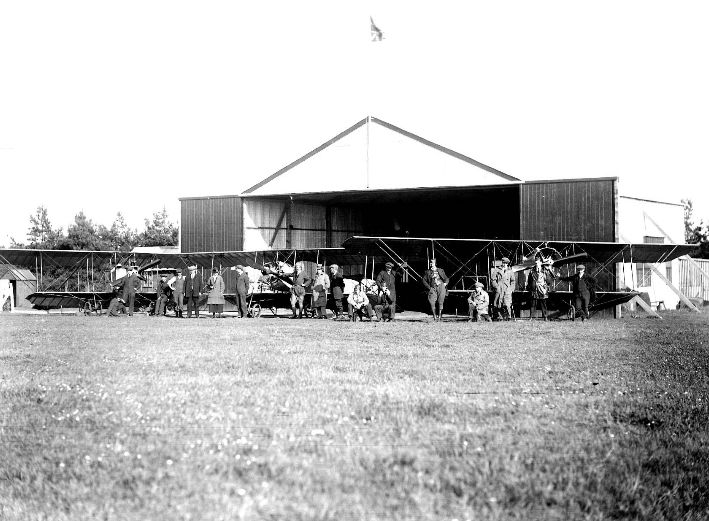
There was avid public interest in flying and at weekends numerous spectators gathered to watch the aircraft.
A (weekly) report from Flight (May 25 1916) stated…..
” Bournemouth School. Pupils rolling alone last week: Messrs. Kennedy, Barlow, Brandon, Pritt, Scaramanga, Daniel, GreenTurner, Hammersley, and Minchliff.
Straights alone: Messrs. Morley, J. Wilson, O. Wilson, Morris, A damson, Smith, Gordinne, and Barlow.
Figures of eight and circuits alone : Messrs. Frank Simpson and Morley.
Instructors: Messrs. S. Summerfield and Brynildten. 35-45 and 60 h.p. Caudrons in use.
Certificate was taken by Mr. Frank Simpson, who attained a height of 1,300 feet, vol plane’d down, landing right on the mark. His flying was exceedingly good.
On Wednesday Mr. Summerfield gave various exhibition flights before a fair-sized crowd, his steep dives being a feature.
The usual number of visitors were again present on Saturday, and witnessed some fine steep banks and spirals by the same pilot. On one flight he attained a height of 3,000 feet, indulging in all sorts of evolutions with engine off.
Towards the evening, two passengers were taken up, one of whom was Mr. C. Hudson, of Birmingham, who had the pleasure of enjoying several stunts performed by Mr. Summerfield at an altitude of 2,000 feet; afterwards, he spiralled down to earth.”
The school moved to nearby Ensbury Park in 1917 and the site reverted to farming.
Ensbury Park, then on the northern outskirts of Bournemouth, took over from Talbot Woods at the beginning of 1917. Although still a civilian flying school, the Bournemouth Aviation Company continued to train pilots for both the RFC and Royal Naval Air Service, as well as Belgians and Canadians. It claimed to be the best -equipped flying school outside London. Aircraft used included Caudron, Curtiss JN-3s and Avro 504s. On 1 April 1918 the Royal Air Force was formed and the site became RAF Winton.
Sam served in the RFC/RAF during the First World War and survived. However, the name of the casualty on the memorial is actually that of his younger brother Sidney who was serving with the 8th Battalion Leicestershire Regiment.
On Friday October 13th 1916 The Melton Mowbray Times & Vale of Belvoir Gazette published the following article under the heading. “MELTON AND THE WAR.” – MELTON SOLDIER’S KILLED. During the past week news has reached Melton Mowbray of the death of several more local soldiers. On Sunday morning Mr. S. Summerfield, butcher, Nottingham-street, received the following letter:- “3rd October, 1916. Dear Mr. Summerfield, – It is our painful duty to write and let you know that poor Sid was instantly killed by a shell on the night of the 24th September. Unfortunately neither of us was near him at the time, so his officer took his papers, and was afterwards wounded. We, being great friends of Sid, can sympathise deeply with you in your great loss. If there is anything further you would like to know, we shall be only too pleased to do anything in our power on hearing from you. Yours sincerely, W. G. Butteriss, E. Simpkins.”
The following letter was received by Mr. Summerfield on Tuesday:- “B.E.F., October 5th. Dear Mr. Summerfield, – I write to you with much regret of the sad news of your son Sidney in the recent action that took place on the 24th September, this being my first opportunity of writing. I hardly know how to write such sad news. Though I was not actually with him at the time, I learn from those who were by his side at the time that a wiz-bang shell bursted against him and caused instant death. having been a great chum of Sidney’s for many years, we always made it understood that whatever happened to either of us, one should break the news if possible, and believe me, I am awfully upset to have to write such heart broken news, yet one never knows out here when your turn may come. I saw Sidney only a few hours before he went into the line, and he was the same as he always has been – very cheerful up to the time I left him. I am sure it is very hard for me to write such sad news, but I think it my duty to tell you the truth. It’s lucky for myself that I am able to do so. Sidney being much liked amongst platoon, and always having a good heart, is very much missed by us, and those who have once more returned along with myself, wish me to send you and family their deepest sympathy. I now close my letter, this being our wish made between us to write home who ever got through safely. I remain, yours truly, Pte. H. Warner.
Pte. Sid Summerfield was the third son of Mr. S. Summerfield, and was 20 years of age. He was educated at Melton Mowbray Grammar School, where he took a foremost place in sports and athletics, and won a number of prizes. Afterwards he played for Egerton Park C.C., and in several matches made big scores, always batting in splendid style and seldom failing to punish home balls. Deceased also became a member of Melton Rugby Football Club, for whom he played half-back, and was also a member of the Young Men’s Institute. At the outbreak of the war he was employed at the Great Northern Railway Station, and at once enlisted in the Leicester’s with his friends, Butteriss, Dixon and Simpkins. It will be remembered that some years ago Pte. Sid Summerfield and his brother Alfred nearly lost their lives on the river at Sysonby, at the time their parents resided at Sysonby House, now known as the Riverside Colony. After a frost they were sliding on the river, when the ice broke, and let them in. Mrs. Summerfield and her two daughters bravely rescued them at the risk of their own lives by forming a human chain, and were afterwards awarded life saving certificates. One of the deceased’s brothers is serving with the forces at Salonika, while another is chief flying instructor at the Bournemouth School. It will be noted from the first letter that Sergt. Simpkins, who was last week stated to have been killed, is still safe.
Sids body was never found and he is commemorated by the Commonwealth War Graves Commission on the Thiepval Memorial on the Somme in France.
In addition to the Thiepval Memorial, Sid is also commemorated locally on the King Edward VII Grammar School War memorial at Sage Cross church, the WW1 tryptych at St Marys Church, the WW1 tablet at the RBL Keswick House and the Egerton Lodge War Memorial.
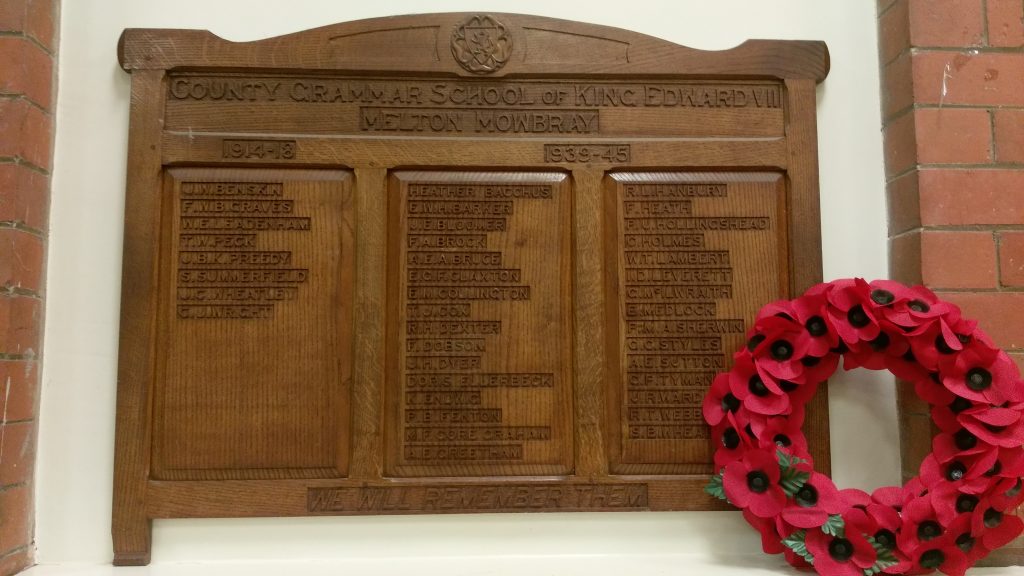
After serving in the RFC/Royal Air Force during the Great War, Sam earnt a living ‘barnstorming’ and providing leisure flights with a travelling air circus. He also served in the Reserve of Air Force Officers (RAFO) where his promotion to Pilot Officer was ‘Gazetted’ on 23rd March 1926. He held this rank until he relinquished his commission in the RAFO on the 23rd March 1931.
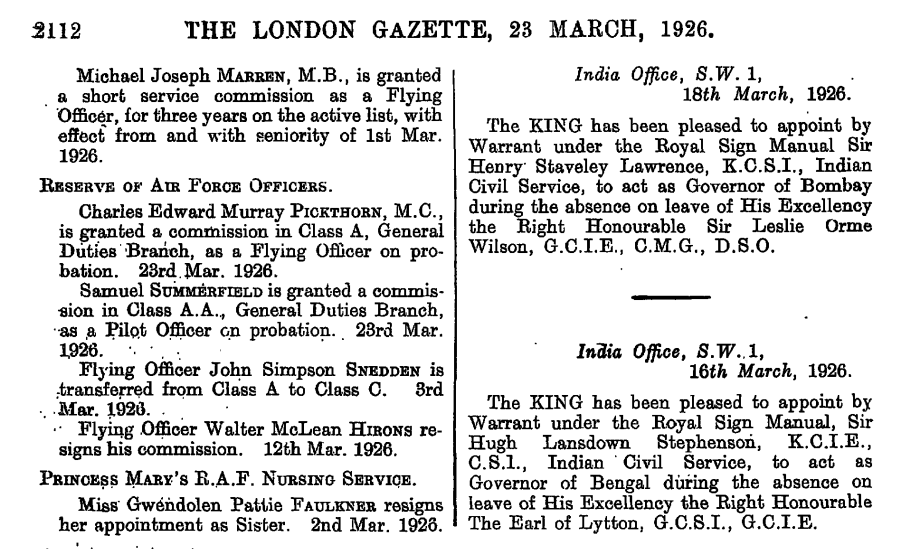
In the summer of 1926, Sam was a pilot working for the Northern Aviation Company taking passengers on pleasure flights. On one occasion, he was the pilot of one such trip with Pearson Hardcastle of Colne Bridge near Huddersfield and Margaret Mercer of Heysham in Lancashire were passengers on a pleasure trip around the Morecambe area.
Shortly after takeoff, Sam noticed an unusual draft around the back of his neck. Almost at the same time as the other passenger touch him on the shoulder, he turned around and saw Pearson Hardcastle in the 2nd seat behind the pilot standing up with his hands above his head. In a flash, the man had disappeared over the side of the plane falling to his death. The inquest into the incident concluded that the man had suffered a sudden heart failure resulting in him falling from the aircraft and no blame was attributed to Sam as the pilot.
Sam, aged 40, made a life-changing commitment when he left England on the 2nd November 1934 aboard the P&O Electric Ship Strathnaver, The first of five Strath Sisters was specifically designed for the UK-Suez-Bombay-Australia run.
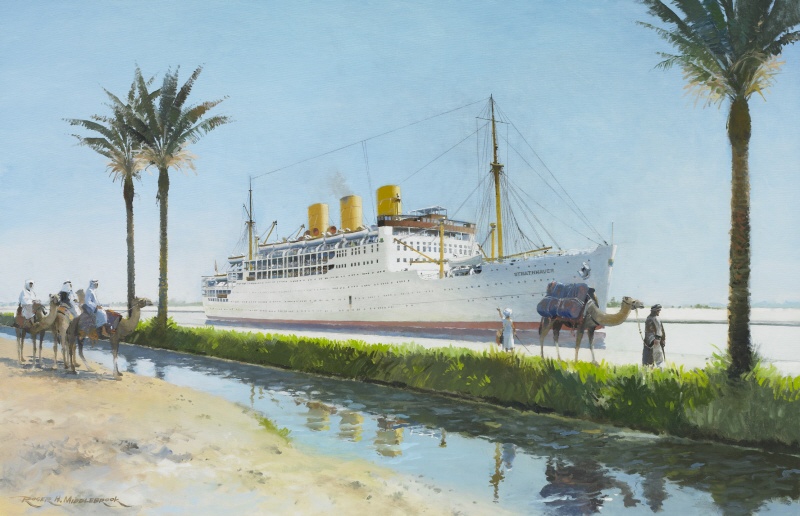
He travelled to Brisbane in Australia with another pilot, 28 year old Maurice Brunton whom he lived with at 13 Lewin Road Lambeth, London SW16. The two pilots travelled 3rd/Tourist class.
Sam had had been flying planes in England and western Europe since before World War One. He had been barnstorming around Queensland and the Northern Territory when he flew into the new Tennant Creek goldfield, being the first plane to ever arrive at the new settlement.
His plane was blown away by a dust storm, and damaged beyond repair. So he stayed on at Tennant Creek as a prospector, owning the Mary Lane lease for 30 years.
The trip ‘down under’ was only intended to be a six months return trip working to earn a few shillings in the ‘off’ season. However, it became a one-way migration when, after a very short period of flying his plans were shattered. He was diagnosed with a hearing defect which had been traced back to his exposure to an explosion in the early days of hostilities of the First World War. The Australian authorities deemed this sufficient enough to prevent him from obtaining a commercial pilot’s licence in Australia which meant that he was never to fly again.
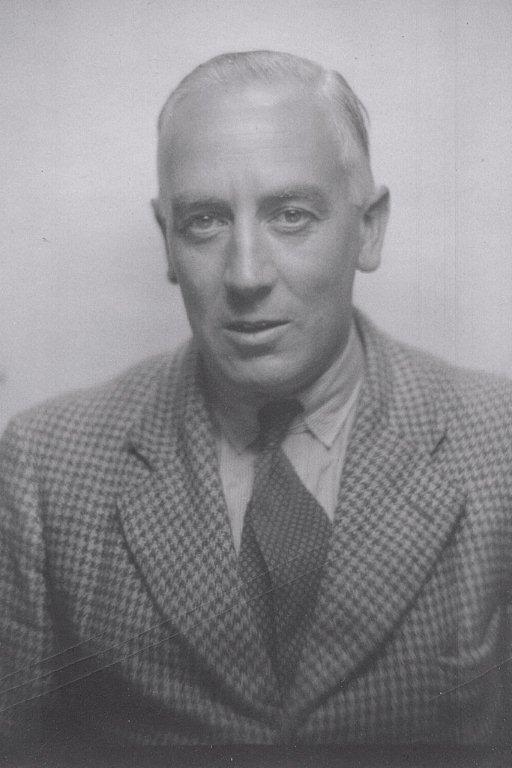
He stopped prospecting in 1966 after falling and breaking a hip, then died the following year on the 2nd April aged 73. He is buried in the small mining town of Tennant Creek.
